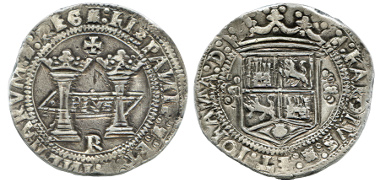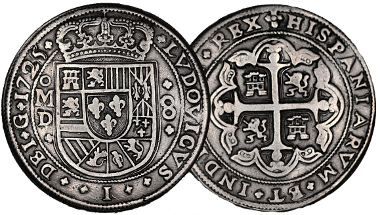05-11-2014 – 01-01-1970
Treasure and World Coin Auction #16
Two of Mexico’s most important historical silver coins to be sold
Numismatic auction house Daniel Frank Sedwick, LLC announces that two of Mexico’s most important historical silver coins will be sold at auction #16 on November 6 in Orlando, Florida.
“We cannot overstress the importance of this auction, both for the history of Mexico and the larger field of North American numismatics,” says company president and founder Daniel Sedwick. “These coins are the absolute root of the concept of the American dollar.”
Foremost is an 8 reales minted in 1538, in the reign of Charles and Joanna of Spain, while Hernan Cortes was still exploring the territory after the Conquest. This coin is widely acknowledged as the first dollar-sized coin struck in the New World and is one of only three known, all of which were found on a shipwreck in the early 1990s, prior to which their existence was known only through contemporary documentation. For over four centuries the survival of these coins was doubted, for they were only briefly made and quickly withdrawn just two years after the opening of the mint in Mexico City, the first mint in the Americas. As double-striking on each of the three known examples demonstrates, the mint had difficulty making these coins, to which legal testimony in 1545 also attests. Two of the three coins found on the shipwreck have been sold at auction already, in 2006 and 2008, before it was known with certainty that only three existed. Those coins sold in the range of $300,000-$400,000, one of them corroded and deemed inferior, and the better specimen held down in price by false suspicions of further examples. This third specimen, never published before and a rival for the best in quality, was rumored to have been offered privately by its owner for $1 million. This is the first time it will be offered publicly.
Mexico, Carlos and Joanna 8 Reales ND (1538). Estimate: $500.000 to $1 million.
Since the re-discovery of certain archival documents by Dr. Alberto Pradeau in 1947, it has been known that the early Mexican Mint did strike large, dollar-sized silver 8 reales in 1538, two years after the Mint began operation. Those documents were the transcripts from an investigation by Francisco Tello de Sandoval in 1545, as ordered by the king in response to accusations of fraud by Hernan Cortés, Spanish conqueror of Mexico. The investigation exposed eyewitness accounts by various mint officials (including Francisco del Rincón, the first assayer at the mint) that 8 Reales were made briefly in 1538 until it was determined that they were too difficult to craft properly under the conditions that existed.
Without a single specimen to prove the existence of these 8 Reales, it was believed that all specimens struck had disappeared forever.
“The auction estimate for this coin will be $500,000 to $1 million, with an unreserved starting price of $475,000,” points out company Vice President Agustin Garcia-Barneche, who also stresses that financial and collectible investment markets in 2006-2008 were not as healthy as they are today. “We already have interested parties, which means this coin could break the record for the highest price ever paid for a ‘dollar’ that was not struck at a US mint. There will be worldwide interest, not just for the coin’s historical importance but also because collectors are confident about its extreme rarity.”
The record for a US-mint dollar is just over $10 million, a price set at auction in 2013 for the finest of over 100 known examples of the 1794 “flowing hair” dollar, the first date of the first series struck in the United States. Spanish colonial coins, particularly from Mexico, were legal tender in the US till 1857, however, and therefore the first “dollar” of Mexico is technically the first such coin of the United States as well. It is widely acknowledged in any case that the 1794 dollar was exactly modeled after the Spanish colonial 8 reales in weight and fineness.
“It will be interesting to see the reaction of the US-dollar collector community for this coin,” says Cori Sedwick Downing, the company’s Administrative Manager and Researcher and author of the NLG award-winning article “The Charles and Joanna Coinage of Mexico City, 1536-1571.” “As a longtime researcher of Mexico’s first coinage, I appreciate what a privilege it is to hold this amazing piece of history in my hands.”
The design of the coin is highly symbolic and artistic, yet simple in principle. The obverse (front side) features a crowned shield housing castles and lions in its quadrants, representing Castile and Leon, with a pomegranate for Granada at the bottom, flanked by Gothic-M mintmarks for Mexico inside a legend (wording around the edge) that shows the name of the king and his mother, Charles and Joanna, who were co-regents of Spain while Charles was Holy Roman Emperor and the insane queen Joanna was considered unfit to rule alone. The reverse of the coin bears the Pillars of Hercules with a banner that shows the word PLVS, meaning “more” (in reference to the ancient motto of NE PLVS VLTRA [“no more beyond”] at the entrance to the Mediterranean), with a Maltese cross at top and initial R for the assayer Francisco del Rincon (the person responsible for the coin’s fineness and quality) at bottom, all inside a continuation of the legend stating the rulers’ territories. The weight of the coin is a full 27 grams, reflecting a total lack of the corrosive loss that normally typifies shipwreck silver coins. Like all hand-struck coins (for machine-struck coins did not begin in the colonies till the early 1700s), this piece is not quite round and bears areas of uneven or even doubled strike, but is richly toned and has bold eye appeal.
It is interesting to note that in addition to being the first “dollar” of the New World, this issue may also bear the distinction of being the first such coin of all the realms of Spain, whose tradition of striking 8 reales spans more than 300 years, from the early 1500s till the mid-1800s. Spain’s first 8-reales issue was a series of coins struck in the names of Ferdinand and Isabella posthumously under Charles and Joanna. It is not known when the striking occurred, but it could have been after 1538, when the Mexican 8 reales were made. Significantly, in the documentation authorizing the Mexican mint to strike 8 reales, there is no reference to current coins being made in Spain. Also, it is interesting to note that the Mexican coins of Charles and Joanna were the first coins ever to announce the “Indies” as a Spanish possession, effectively the end of the Middle Ages and the beginning of the Americas.
Most important is the fact that this Mexican “first American dollar” is not represented in any public numismatic museums anywhere, particularly the Casa de Moneda and Banco de Mexico in Mexico City, and the Casa de Moneda and the Museo Arqueológico de España in Madrid, Spain. This piece is lacking in even the largest, most globally encompassing museums, which must adhere to the principle of including the world’s historically most important coins, of which this coin sits undeniably among the top ten.
“Only three people or institutions, at most, can own a specimen of this highly important coin,” emphasizes Sedwick, “and opportunities like this are as rare as the coins themselves.”
Mexico, 8 Reales Royal, Louis I, 1725D. Estimate: $125.000,00.
Another important Mexican “dollar” being auctioned by Sedwick is a “Royal” round presentation 8 reales struck in 1725 posthumously under the Spanish king Louis I, who reigned for just six months at the age of 17 before dying of smallpox. The standard issues at the time were crude, usually rectangular lumps of silver that barely showed 50% of the intended details, but introduction of machinery made it possible to create a perfectly round and perfectly struck beauty such as this coin, which shows the full Bourbon coat-of-arms on the obverse, flanked with mintmark oM, assayer D and denomination VIII, all inside a legend
stating the name of the king and the date 1725. The reverse shows a cross with castles and lions in the quadrants. About three examples are known. Pre-auction estimate for this piece, which grades VF, is $125,000.
Printed catalogs will be available for order around beginning of October on Sedwick’s website.
For more details about the auction, including hotel reservations, please call 407-975-3325 or send an email.
Asistencia en español disponible.






